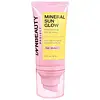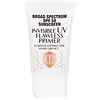iNNBEAUTY PROJECT Mineral Sun Glow Broad Spectrum SPF 43 PA +++ Versus Charlotte Tilbury Invisible UV Flawless Primer Broad Spectrum SPF 50
What's inside
What's inside
 Key Ingredients
Key Ingredients

 Benefits
Benefits

 Concerns
Concerns

 Ingredients Side-by-side
Ingredients Side-by-side

Zinc Oxide 14.28%
Cosmetic ColorantWater
Skin ConditioningCaprylic/Capric Triglyceride
MaskingPropanediol
SolventCoco-Caprylate/Caprate
EmollientPentaerythrityl Tetraisostearate
EmollientDimethicone
EmollientButyloctyl Salicylate
Skin ConditioningGlyceryl Stearate Citrate
EmollientSqualane
EmollientPolyglyceryl-3 Stearate
EmulsifyingMethyl Dihydroabietate
Capryloyl Glycerin/Sebacic Acid Copolymer
Skin ConditioningPalmitoyl Tripeptide-5
Skin ConditioningPalmitoyl Tripeptide-1
Skin ConditioningPalmitoyl Tetrapeptide-7
Skin ConditioningTetrahexyldecyl Ascorbate
AntioxidantOryza Sativa Extract
AbsorbentOryza Sativa Germ Extract
EmollientNiacinamide
SmoothingSuperoxide Dismutase
AntioxidantResveratrol
AntioxidantBisabolol
MaskingAllantoin
Skin ConditioningRhodomyrtus Tomentosa Fruit Extract
HumectantPongamia Pinnata Seed Extract
Skin ConditioningLeuconostoc/Radish Root Ferment Filtrate
AntimicrobialPolygonum Aviculare Extract
EmollientGlycerin
HumectantButylene Glycol
HumectantPhospholipids
Skin ConditioningSorbitol
HumectantSodium Lactate
BufferingSerine
MaskingUrea
Buffering1,2-Hexanediol
Skin ConditioningVp/Eicosene Copolymer
Polyglyceryl-3 Polyricinoleate
EmulsifyingLecithin
EmollientPolyhydroxystearic Acid
EmulsifyingIsostearic Acid
CleansingC12-15 Alkyl Benzoate
AntimicrobialXanthan Gum
EmulsifyingEthylene/Propylene/Styrene Copolymer
Polyglyceryl-3 Diisostearate
EmulsifyingPentylene Glycol
Skin ConditioningPolysilicone-11
Caprylhydroxamic Acid
Sodium Phytate
Lactic Acid
BufferingPalmitic Acid
EmollientButylene/Ethylene/Styrene Copolymer
Sodium Chloride
MaskingCetearyl Olivate
Polyacrylate Crosspolymer-6
Emulsion StabilisingTocopherol
AntioxidantHydrogenated Lecithin
EmulsifyingGlycine Soja Oil
EmollientPentaerythrityl Tetra-Di-T-Butyl Hydroxyhydrocinnamate
AntioxidantSorbitan Laurate
EmulsifyingC18-36 Acid Triglyceride
EmollientC18-36 Acid Glycol Ester
EmollientIron Oxides
CI 77492
Cosmetic ColorantMica
Cosmetic ColorantTitanium Dioxide
Cosmetic ColorantCI 77891
Cosmetic ColorantCI 77491
Cosmetic ColorantCI 77499
Cosmetic ColorantZinc Oxide 14.28%, Water, Caprylic/Capric Triglyceride, Propanediol, Coco-Caprylate/Caprate, Pentaerythrityl Tetraisostearate, Dimethicone, Butyloctyl Salicylate, Glyceryl Stearate Citrate, Squalane, Polyglyceryl-3 Stearate, Methyl Dihydroabietate, Capryloyl Glycerin/Sebacic Acid Copolymer, Palmitoyl Tripeptide-5, Palmitoyl Tripeptide-1, Palmitoyl Tetrapeptide-7, Tetrahexyldecyl Ascorbate, Oryza Sativa Extract, Oryza Sativa Germ Extract, Niacinamide, Superoxide Dismutase, Resveratrol, Bisabolol, Allantoin, Rhodomyrtus Tomentosa Fruit Extract, Pongamia Pinnata Seed Extract, Leuconostoc/Radish Root Ferment Filtrate, Polygonum Aviculare Extract, Glycerin, Butylene Glycol, Phospholipids, Sorbitol, Sodium Lactate, Serine, Urea, 1,2-Hexanediol, Vp/Eicosene Copolymer, Polyglyceryl-3 Polyricinoleate, Lecithin, Polyhydroxystearic Acid, Isostearic Acid, C12-15 Alkyl Benzoate, Xanthan Gum, Ethylene/Propylene/Styrene Copolymer, Polyglyceryl-3 Diisostearate, Pentylene Glycol, Polysilicone-11, Caprylhydroxamic Acid, Sodium Phytate, Lactic Acid, Palmitic Acid, Butylene/Ethylene/Styrene Copolymer, Sodium Chloride, Cetearyl Olivate, Polyacrylate Crosspolymer-6, Tocopherol, Hydrogenated Lecithin, Glycine Soja Oil, Pentaerythrityl Tetra-Di-T-Butyl Hydroxyhydrocinnamate, Sorbitan Laurate, C18-36 Acid Triglyceride, C18-36 Acid Glycol Ester, Iron Oxides, CI 77492, Mica, Titanium Dioxide, CI 77891, CI 77491, CI 77499
Water
Skin ConditioningEthylhexyl Methoxycinnamate
UV AbsorberEthylhexyl Salicylate
UV AbsorberButylene Glycol
HumectantDiethylhexyl Succinate
EmollientButyl Methoxydibenzoylmethane
UV AbsorberGlycerin
HumectantOctocrylene
UV AbsorberDextrin Palmitate
EmulsifyingPentylene Glycol
Skin ConditioningHydroxyethyl Acrylate/Sodium Acryloyldimethyl Taurate Copolymer
Emulsion StabilisingPhenoxyethanol
PreservativePEG-60 Glyceryl Isostearate
Marrubium Vulgare Extract
Skin ConditioningCI 77891
Cosmetic ColorantPolyglyceryl-2 Triisostearate
EmulsifyingTalc
AbrasiveHydroxypropyl Methylcellulose Stearoxy Ether
Polysorbate 60
EmulsifyingSorbitan Isostearate
EmulsifyingAgar
MaskingTocopherol
AntioxidantXanthan Gum
EmulsifyingCI 77492
Cosmetic ColorantIsopropyl Titanium Triisostearate
EmollientAluminum Hydroxide
EmollientSodium Hyaluronate
HumectantCI 77491
Cosmetic ColorantKhaya Senegalensis Bark Extract
Skin ProtectingMaltodextrin
AbsorbentCitric Acid
BufferingBHT
AntioxidantAscorbyl Glucoside
AntioxidantCamellia Oleifera Seed Oil
Skin ConditioningButyrospermum Parkii Butter
Skin ConditioningRosa Canina Fruit Oil
EmollientSodium Hydroxide
BufferingCI 77499
Cosmetic ColorantPlumeria Alba Flower Extract
Skin ConditioningPotassium Sorbate
PreservativeSodium Benzoate
MaskingAloe Barbadensis Leaf Extract
EmollientSolanum Tuberosum Pulp Extract
SmoothingAscorbyl Dipalmitate
AntioxidantWater, Ethylhexyl Methoxycinnamate, Ethylhexyl Salicylate, Butylene Glycol, Diethylhexyl Succinate, Butyl Methoxydibenzoylmethane, Glycerin, Octocrylene, Dextrin Palmitate, Pentylene Glycol, Hydroxyethyl Acrylate/Sodium Acryloyldimethyl Taurate Copolymer, Phenoxyethanol, PEG-60 Glyceryl Isostearate, Marrubium Vulgare Extract, CI 77891, Polyglyceryl-2 Triisostearate, Talc, Hydroxypropyl Methylcellulose Stearoxy Ether, Polysorbate 60, Sorbitan Isostearate, Agar, Tocopherol, Xanthan Gum, CI 77492, Isopropyl Titanium Triisostearate, Aluminum Hydroxide, Sodium Hyaluronate, CI 77491, Khaya Senegalensis Bark Extract, Maltodextrin, Citric Acid, BHT, Ascorbyl Glucoside, Camellia Oleifera Seed Oil, Butyrospermum Parkii Butter, Rosa Canina Fruit Oil, Sodium Hydroxide, CI 77499, Plumeria Alba Flower Extract, Potassium Sorbate, Sodium Benzoate, Aloe Barbadensis Leaf Extract, Solanum Tuberosum Pulp Extract, Ascorbyl Dipalmitate
 Reviews
Reviews

Ingredients Explained
These ingredients are found in both products.
Ingredients higher up in an ingredient list are typically present in a larger amount.
Butylene Glycol (or BG) is used within cosmetic products for a few different reasons:
Overall, Butylene Glycol is a safe and well-rounded ingredient that works well with other ingredients.
Though this ingredient works well with most skin types, some people with sensitive skin may experience a reaction such as allergic rashes, closed comedones, or itchiness.
Learn more about Butylene GlycolCi 77491 is also hydrated iron III oxide. It's sole purpose is to give a red/pink hue to products.
Iron III oxides are classified as inorganic chemicals for coloring.
Synthetically created Ci 77491 is considered safer than those naturally found. This is because the synthetically created version may contain less impurities. Iron oxides are generally non-toxic and non-allergenic.
Learn more about CI 77491Ci 77492 is also hydrated iron III oxide. It's sole purpose is to give a yellow hue to products.
Iron III oxides are classified as inorganic chemicals for coloring.
Synthetically created Ci 77492 is considered safer than those naturally found. This is because the synthetically created version may contain less impurities. Iron oxides are generally non-toxic and non-allergenic.
Learn more about CI 77492Ci 77499 is also hydrated iron III oxide. It is created from mixing red and black iron oxides. This helps give shades of darkness to a product.
Iron III oxides are classified as inorganic chemicals for coloring.
Ci 77891 is a white pigment from Titanium dioxide. It is naturally found in minerals such as rutile and ilmenite.
It's main function is to add a white color to cosmetics. It can also be mixed with other colors to create different shades.
Ci 77891 is commonly found in sunscreens due to its ability to block UV rays.
Learn more about CI 77891Glycerin is already naturally found in your skin. It helps moisturize and protect your skin.
A study from 2016 found glycerin to be more effective as a humectant than AHAs and hyaluronic acid.
As a humectant, it helps the skin stay hydrated by pulling moisture to your skin. The low molecular weight of glycerin allows it to pull moisture into the deeper layers of your skin.
Hydrated skin improves your skin barrier; Your skin barrier helps protect against irritants and bacteria.
Glycerin has also been found to have antimicrobial and antiviral properties. Due to these properties, glycerin is often used in wound and burn treatments.
In cosmetics, glycerin is usually derived from plants such as soybean or palm. However, it can also be sourced from animals, such as tallow or animal fat.
This ingredient is organic, colorless, odorless, and non-toxic.
Glycerin is the name for this ingredient in American English. British English uses Glycerol/Glycerine.
Learn more about GlycerinPentylene glycol is typically used within a product to thicken it. It also adds a smooth, soft, and moisturizing feel to the product. It is naturally found in plants such as sugar beets.
The hydrophilic trait of Pentylene Glycol makes it a humectant. As a humectant, Pentylene Glycol helps draw moisture from the air to your skin. This can help keep your skin hydrated.
This property also makes Pentylene Glycol a great texture enhancer. It can also help thicken or stabilize a product.
Pentylene Glycol also acts as a mild preservative and helps to keep a product microbe-free.
Some people may experience mild eye and skin irritation from Pentylene Glycol. We always recommend speaking with a professional about using this ingredient in your routine.
Pentylene Glycol has a low molecular weight and is part of the 1,2-glycol family.
Learn more about Pentylene GlycolTocopherol (also known as Vitamin E) is a common antioxidant used to help protect the skin from free-radicals and strengthen the skin barrier. It's also fat soluble - this means our skin is great at absorbing it.
Vitamin E also helps keep your natural skin lipids healthy. Your lipid skin barrier naturally consists of lipids, ceramides, and fatty acids. Vitamin E offers extra protection for your skin’s lipid barrier, keeping your skin healthy and nourished.
Another benefit is a bit of UV protection. Vitamin E helps reduce the damage caused by UVB rays. (It should not replace your sunscreen). Combining it with Vitamin C can decrease sunburned cells and hyperpigmentation after UV exposure.
You might have noticed Vitamin E + C often paired together. This is because it is great at stabilizing Vitamin C. Using the two together helps increase the effectiveness of both ingredients.
There are often claims that Vitamin E can reduce/prevent scarring, but these claims haven't been confirmed by scientific research.
Learn more about TocopherolWater. It's the most common cosmetic ingredient of all. You'll usually see it at the top of ingredient lists, meaning that it makes up the largest part of the product.
So why is it so popular? Water most often acts as a solvent - this means that it helps dissolve other ingredients into the formulation.
You'll also recognize water as that liquid we all need to stay alive. If you see this, drink a glass of water. Stay hydrated!
Learn more about WaterXanthan gum is used as a stabilizer and thickener within cosmetic products. It helps give products a sticky, thick feeling - preventing them from being too runny.
On the technical side of things, xanthan gum is a polysaccharide - a combination consisting of multiple sugar molecules bonded together.
Xanthan gum is a pretty common and great ingredient. It is a natural, non-toxic, non-irritating ingredient that is also commonly used in food products.
Learn more about Xanthan Gum